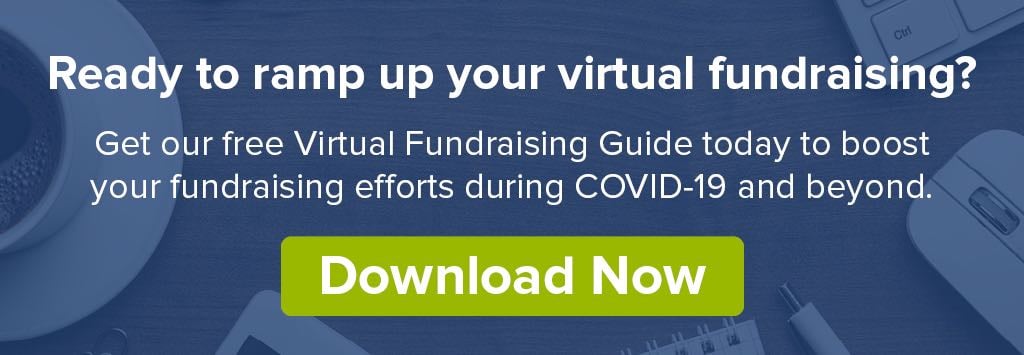
The COVID-19 pandemic transformed life as usual, practically overnight. If you’re a development professional or nonprofit fundraiser, you’re probably inundated with content urging you to contact your donors ASAP. Since none of us has communicated with donors during a global pandemic, what are the new "best practices" that we should be following?
Our community doesn’t have all the answers yet, but we do have early information that will help you create a plan to communicate with your donors and supporters in the coming weeks and months. We’ve also identified the categories of donors you should prioritize contacting. The more proactive you are, the better off your nonprofit will be in the long run.
Segment Your Donor List To Improve Communication During the Coronavirus
It’s essential to segment your contact list when everything is normal, so you can give everyone the most relevant information. Now that we’re navigating a global pandemic, it’s more important than ever to properly segment your donor list so you can communicate the right info to the right donors more quickly.
Email segmentation is the process of categorizing your email list according to specific criteria, like location, background, giving status, or other information. It’s a way to ensure everyone receives the most important and relevant information while saving you time and energy.
Businesses use email segmentation to target promotions, identify customers who haven’t shopped in a while, improve their open and click-through rates, decrease bounce rates, and reduce unsubscribe rates.
Nonprofits should segment their email lists for many of the same reasons that businesses do. People are naturally more interested in some of your activities and programs than others. Some of your donors want more frequent updates than others.
Just like with businesses, segmented emailing improves response rates and lets you better serve your donors. You’ll be able to tailor your fundraising messages and provide exactly what your supporters want, which is critical as we learn how to navigate the coronavirus pandemic.
Donor Segments You Should Contact During COVID-19
These are a few donor segments every nonprofit should be in communication with over the coming days, weeks, and months. The information you give to each group might not be very different. Still, it’s critical to check on your donors. Make sure they’re ok. Thank them for their generosity. Let them know how you’re continuing to provide services (or how will resume your work as soon as possible).
Your largest donors
Of course, every donor is valuable. Yet, according to the "80/20 principle" (also called the Pareto Principle), about 80% of funding comes from around 20% of your donors.
In difficult social and financial times, healthy relationships with donors sustain nonprofits. It’s essential to identify these top donors so you can keep them informed and maintain a healthy relationship with them.
Long term supporters and monthly donors
Your donors who continue to support you over the long term (more than 3 to 5 years), are very likely to name your organization in their will or leave you a bequest. Even if they aren’t your most significant donors, they might be your most loyal supporters.
Monthly donors can be up to 10 times more valuable over time than other donors. As the impact of the coronavirus continues to take shape, household budgets are sure to tighten. People may soon start to reduce their monthly charitable giving. Checking in to make sure they’re ok and let them know what their support is accomplishing will encourage them to continue giving for as long as possible.
Corporate sponsors
All kinds of businesses are closing for at least the next few weeks. Some of your regular corporate sponsors might already be hurting financially. Take the time to contact them to show your concern. A good business practice is to have one of your board members or the head of your organization reach out to the CEO or owner of long term corporate sponsors.
Your crowdfunding leaders
Contact your influential volunteers and donors, those who lead the charge in your peer-to-peer fundraising campaigns and volunteer efforts. These people have gone out of their way in the past to help you raise hundreds or thousands of dollars with birthday fundraisers, charity runs, and social media campaigns.
Your crowdfunding leaders are already well-versed at creative fundraising, networking, and asking for donations on your behalf. You might be relying more heavily on crowdfunding and other online fundraising strategies for at least the short term.
While you’re connecting with your crowdfunders, take some time to reach out to people who are very active on your social media pages. They’re likely to be excellent recruits to your crowdfunding community.
People who already pledged to give
Some of your supporters don’t give monthly, but they pledge regular gifts. Reach out to all your donors with planned gifts. You won’t want to miss any expected revenue.
If your supporters need to change the size or schedule of their gifts, be sure to show compassion and prioritize caring for them over collecting the donation. Remember, healthy relationships with your donors will help ensure they continue to give in the future.
New donors
New donors are the most likely to donate once and not give again, simply because they don’t have a strong relationship with your organization yet. Personal interaction with new donors increases the likelihood that they’ll give in the future.
Communicate your gratitude as quickly as possible with a phone call and thank you notes. Be sure to tell stories about how their generosity is making an impact.
Each donor category includes people who can give at all levels. Now is the time to make sure you are cultivating healthy relationships with all your donors! Remember, every donor is essential. It’s more critical than ever to treat each donor, volunteer, and sponsor with respect, care, and compassion, regardless of their giving capacity.
Start by making sure your email list is organized correctly, then make a plan to connect with each of your donors and sponsors over the next few days and weeks.
Here are three more resources to help boost your donor care and fundraising strategies.
- Fundraising Experts’ Advice During the Coronavirus [Updated Daily]: As we learn how to fundraise amidst a global pandemic, it’s critical to pool our resources and learn from each other. This resource is an up-to-date database of recommendations, ideas, and resources from fundraising experts around the world.
- 4 Ways To Protect Donation Levels During the Coronavirus: Everyone is feeling a lot of uncertainty and fear as we navigate the coronavirus pandemic. Donor care is critical in this season of change. Even small actions will build trust and make your donors want to continue supporting your nonprofit.
- 5 Ways To Make Your Peer-To-Peer Fundraising Campaign More Successful: Social distancing is now a part of our everyday language. Many nonprofits are canceling or postponing in-person fundraising events. One excellent fundraising alternative is peer-to-peer fundraising! You’ll be able to mobilize your loyal supporters to help you raise critical funds without relying on gatherings or events. Learn how to organize an effective peer-to-peer fundraising campaign.
